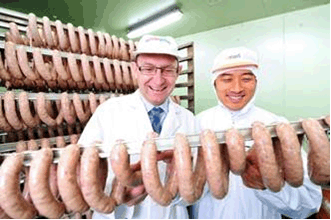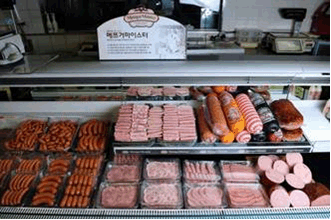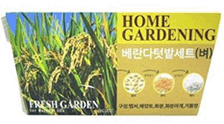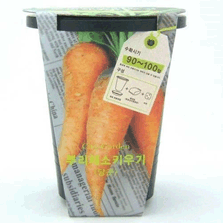
Market Information > Food News Clipping
Food News Clipping
February 10, 2014
2014.02.11
FAS/Seoul Monitoring of Media Reporting on Agricultural Issues
Today's Date: Monday February 10, 2014
For Coverage: February 1 - 10, 2014
1. ECONOMIC ISSUES
[Trend Report on Agricultural Imports] The amount of agricultural imports is recorded as US$30.4 billion in 2013, ranking the highest of all time [Korean, KSY]
http://www.nongmin.com/article/ar_detail.htm?ar_id=228422&page=
SUMMARY: According to ¡°Trend Report on Agricultural Imports¡± by KREI, the amount of imported agricultural products last year recorded 30.4 billion US dollars, reaching the highest of all time. The reason behind this is the higher cost of import caused by ever-rising Chinese consumption and poor harvest due to abnormal climate changes. In particular, the amount of agricultural imports from countries with FTAs recorded US$15.3 billion, which is more than half of the total. These countries are benefiting from the preferential tariff of FTA.
2. GRAIN & OILSEED ISSUES
Consumption of Rice, Largest Drop in 10 Years [Korean, KJM]
http://www.nongmin.com/article/ar_detail.htm?ar_id=228235&page=undefined
Summary: Last year, yearly consumption of rice per capita dropped to 67kg, recording the largest decrease in 10 years. According to the announcement made by the National Statistical Office (NSO), this is a 3.7% reduction compared to 2012¡¯s consumption of 69.8kg. Since the 130.1kg level of rice consumption per capita in 1984, the consumption rate has continuously decreased and therefore resulted in a yearly average reduction rate of 2.2% in recent 10 years. It¡¯s the same with the business sector. While the rice cakes, processed grains, and noodle industry¡¯s consumption of rice increased, the alcohol industry¡¯s consumption has decreased. However, apart from the rice, the yearly per capita consumption of other grains last year, has recovered its consumption level of 8.1kg after 5 years and now is showing an increasing trend of consumption.
3. LIVESTOCK ISSUES
Two farms in Hwaseong, Gyeonggi and Youngam, Jeonnam Diagnosed with HPAI [Korean, KSY]
http://www.mafra.go.kr/list.jsp?&newsid=155445358§ion_id=
http://news.donga.com/3/all/20140210/60699352/1
SUMMARY: A farm in Hawseong, Gyeonggi and another farm in Youngam, Jeonnam were diagnosed with H5N8 virus on the 8th. There have been 17 cases of HPAI outbreak. Assistant Deputy Minister Lee of MAFRA said that the virus that had spread during the holidays might not have shown any symptoms yet. He added that disease control activities will proceed in other regions of the country.
PED and Other the Swine Epidemic on the Rise [Korean, KSY]
http://www.nongmin.com/article/ar_detail.htm?ar_id=228433&subMenu=articletotal
SUMMARY: According to research done by Korea Pork Producers Association, there were 75 (Poricine Epidemic Diarrhea) PED outbreaks in 30 towns except Gangwon and Jeju regions in January. The plague is affecting the price of piglets. Prices for pigs will go up by 30~40%, estimated to be around 200,000 won this month. Meanwhile, MAFRA request travelers from Russia be prevented from entering the country to avoid African Swine Fever (ASF) and Foot and Mouth Disease (FMD) from spreading into Korea.
Suspected AI report from Busan Shows Negative Result... Number of Reports on the Wane [Korean, KSY]
http://news.sbs.co.kr/section_news/news_read.jsp?news_id=N1002219309
SUMMARY: The only farm suspected of AI in Busan showed a negative result. The number of suspected reports filed is on the downward path. The authorities assume that the worst danger is over, considering the fact that the past AI outbreaks reached its peak on the third week then showed decrease. However, preventive quarantine will continue.
Market Share of U.S. beef in Decline for 2 Consecutive Years [Korean, KSY]
http://www.yonhapnews.co.kr/economy/2014/02/05/0302000000AKR20140205171600030.HTML
SUMMARY: According to USMEF and KITA, the amount of U.S. beef exported to Korea in 2013 totaled 92,145 tons. The U.S. took 34.5% of the imported beef market share, which is a continuous decrease from 37.5% in 2011 and 36.0% in 2012. The biggest beef exporter to Korea in 2013 was Australia (147,173 tons, 55% of the market share), followed by the U.S., and then New Zealand (25,345t, 9.5%). This is caused by the decrease in U.S. beef supplies and the rise in U.S. feed prices. Meanwhile, the U.S. was the biggest pork exporter to Korea, exporting 190,987 tons and taking 34.5% of the market share. The price of U.S. pork became more competitive thanks to the reduction and elimination of tariffs under the KORUS-FTA.
Price of Pork Expected to Rise 30% in June [Korean, KSY]
http://www.mt.co.kr/view/mtview.php?type=1&no=2014020514435080056&outlink=1
SUMMARY: Price of pork is expected to rise 30% this June, compared to last year¡¯s average. This is because of the increase in demand caused by AI and decrease in supply due to porcine epidemic diarrhea (PED). According to MAFRA, the carcass price of pork will be average of 3,800~4,000 won per kilo this year. However, the price is expected to surge to 4,500~4,700 won per kilo in June.
Another Suspected AI Report from a Chicken Farm in Muan [Korean, KSY]
http://www.etoday.co.kr/news/section/newsview.php?idxno=863561
SUMMARY: Another suspected AI report was filed by a native chicken farm in Muan, Jeonbuk, located outside the AI boundary area. The result showed negative in the brief antigen examination, while a thorough investigation is underway. 2.67 million birds in 118 poultry farms were culled l the 4th of January and, 0.15 million more are waiting to be culled.
Countermeasures Taken Against AI by MAFRA [Korean, KSY]
http://www.mafra.go.kr/list.jsp?&newsid=155445335§ion_id
Summary: There were four more suspected AI reports over the Lunar New Year¡¯s holidays; two on the 1st(Jincheon, Chungbuk and Gangseo, Busan) and two on the 2nd(Eumseong, Chungbuk and Jeong-eup, Jeonbuk). An epidemiological investigation is underway for two farms in Chungbuk, since they are both in the 10km radius of the previous outbreak (11th outbreak in Jincheon, Chungbuk). The report from Busan was detected before the shipment. The diagnostic kit showed negative response while a thorough survey is ongoing. The government received report from Jeonbuk around 1:00 PM.
Based on the talks during a livestock disease control conference, MAFRA will oversee the measures taken up to this moment and take special measures on each of the outbreak farms. A joint inspection by relevant authorities, such as MAFRA and Ministry of Security and Public Administration (MOSPA), is scheduled in early February. There will be a reduction in compensation for the farms that did not follow the preventive measures. The farms with a history of AI will be examined regularly, as those farms have higher chances of recurrence.
Korean Government to Introduce Pork Traceability System by the End of This Year [Korean, KSY]
http://imnews.imbc.com/replay/2014/nwdesk/article/3411358_13490.html
Summary: The Korean government has decided to manage the record of pork production. A 12-digit identification number will be given to each pig and the whole history of the pig - how it was raised, slaughtered, and processed- will be provided to the consumers through smart phones. There will be extensive crackdowns on pork vendors 6 months after the implementation of the traceability system.
4. MARKETING ISSUES
Leading Snack & Beverage Producers Increase Price by 7 to 20 percent [Korean, OSY]
http://news.naver.com/main/read.nhn?mode=LSD&mid=sec&sid1=103&oid=015&aid=0003028982
Summary: Many leading producers of popular snack and beverage products in Korea have announced price increases recently. Price increases have been quite significant from 6.5 percent by Coca-Cola Korea to 20 percent by Orion, producer of ¡®Choco Pie¡¯.
E Mart to Launch ¡°Fresh Made In-Store Sausages¡± This Month [Korean, OSY]
http://news.inews24.com/php/news_view.php?g_serial=801697&g_menu=022500&rrf=nv
Summary: E Mart announced on February 6 that four of its stores would be equipped with sausage processing facility and start to sell ¡°fresh made in-store¡± sausages within this month. E Mart said that the number of stores selling ¡°fresh made in-store¡± sausages would increase as much as to 80 by the end of this year. E Mart added that the sausages will mainly use fresh local pork meat, which will help local livestock farmers generate additional profit while offering high quality products at a lower price to the consumers.


http://www.hankyung.com/news/app/newsview.php?aid=2014020635161
Summary: Naver.com, the leading internet portal site in Korea announced on February 6 that its on-line agricultural marketplace would start business operations beginning February 17. Naver¡¯s on-line agricultural marketplace will only allow direct transactions between farmers and consumers, excluding middleman distributors. Naver added that the on-line agricultural market will help expand demand for local food by lowering the transaction cost.
Retailers Focus on Low Price Chocolates for the Valentine¡¯s Day Season This Year [Korean, OSY]
http://news.donga.com/3/all/20140205/60604188/1
Summary: Retailers are reportedly focusing more on low-priced chocolate products for the upcoming Valentine¡¯s Day, reflecting on-going economic concerns of consumers. GS25, a leading convenience store chain has reported that 74 percent of chocolate products that it offers for Valentine¡¯s Day season are less than 10,000 won ($about $9) each. ¡®One plus one¡¯ offers are also found in most of the local retail stores.
¡®Bee Hive Ice Cream¡¯ Reports Early Success in Seoul ¡¦ Opened 15 Shops within One Year [Korea, OSY]
http://news.donga.com/3/all/20140205/60578811/1

Aekyung Group Enters Food Business ¡¦ Launches ¡®Health &¡¯ Brand [Korean, OSY]
http://news.donga.com/3/all/20140203/60554156/1
Summary: Aekyung Group, a leading player in home chemical goods, announced on February 3 that its first consumer food brand, ¡®Health &¡¯ was launched. Aekyung Group added that its food business would mainly target health functional products, as indicated by the fact that it¡¯s first product under ¡®Health &¡¯ brand was granular yoghurt mix. The granular yoghurt mix contains healthy ingredients such as walnut, almond, and sunflower seeds and can be served quickly by pouring water.

Coffee Market in Korea Signals Saturation ¡¦ Café Industry Seeks to Launch Non-coffee Products to Compensate for the Threat [Korean, OSY]
http://www.hankyung.com/news/app/newsview.php?aid=2014020288451
Summary: It is reported that coffee market in Korea has come to a saturation point. According to industry data, the number of coffee servings that each Korean consumed on average in 2013 was 307, which was 31 servings less than 2011. Reflecting the trend, the café industry has been trying to offer non-coffee products to develop new growth momentum. For example, Starbucks Korea reported that coffee accounted for 87.9 percent of its sales in 2013, down from 89.9 percent in 2011. Cafebenne, another leading café chain, reported that coffee accounted for 65 percent of its sales in 2013, down from 72 percent in the previous year. Non-coffee products that the industry have been focusing on ice dessert (¡®Bingsoo¡¯, a local product) and sandwiches. Leading players have reportedly beefed up their recipe development teams in an effort to offer more diverse non-coffee menus in the coming months.
Korea¡¯s Kimchi Trade Deficit Expands to $30 Million in 2013 [Korean, OSY]
http://news.donga.com/3/all/20140202/60529056/1
Summary: According to Korean government data, Korea saw $30 million of trade deficit in Kimchi, one of its most famous local foods, in 2013. While Korea¡¯s Kimchi exports amounted to $95 million in 2013, down 16.3 percent from the previous year largely due to reduced export to Japan, Korea¡¯s imports of Kimchi increased 5.9 percent to $125 million. Strong import demand for low-priced Kimchi from China is likely to continue in 2014.
Sales of Traditional Korean Liquor Continues to Decline [Korean, OSY]
http://news.donga.com/3/all/20140202/60529118/1
Summary: According to Korea Statistics Office (KSO), estimated sales of traditional local liquor, including rice wine, in 2013 was 395,000 kiloliters, down over 7 percent from the previous year. KSO pointed out that strong growth of other liquor, particularly beer and wine, had caused sluggish consumption growth of traditional local liquor since 2012.
E Mart Launches ¡°Home Farming Kits¡± for Rice, Radish and Carrots [Korean, OSY]
http://news.naver.com/main/read.nhn?mode=LSD&mid=sec&sid1=101&oid=001&aid=0006730021
 |
 |
5. OTHER MISCELLANEOUS ISSUES
Import Volume of Oranges Fall as the Price Increases [Korean, KJM]
http://www.nongmin.com/article/ar_detail.htm?ar_id=228250&page=undefined
Summary: According to the Agriculture & Food Corporation of Seoul, the Californian orange named ¡®Navel¡¯ which flourished in the domestic market, has been imported between December to May. However, the import volume of Navel orange this year fell due to the rise of its local price. In January of last year, in the Korean Garak market, the average wholesale volume of Navel oranges reached 56.6 tons, whereas this year January, the amount halted at only 25.5 tons. Likewise, compared to the last year¡¯s price, the local price of imported oranges rose by 14% costing 53 thousand won per 18 kilograms. These consequences are anticipated to be the results of the cold wave in California at the end of last year which led to the prohibited harvesting of oranges that were damaged. Meanwhile, with the downswing of imported oranges in the market, increased purchase of domestic fruits such as apples and tomatoes are likely.
Excessive Supply of Roughage [Korean, KSY]
http://www.agrinet.co.kr/news/news_view.asp?idx=124816&main_idx
SUMMARY: Supply of roughage is exceeding demand due to last year¡¯s good harvest of winter crop and favorable weather for collecting straws after the rice harvest. The straws collected last year are still in stock, and the production of winter crop is predicted to increase by 10%. Therefore, the Korean government is trying to control the supply by reducing quota tariff import of roughage to 0.8 million ton.
The information in this report was compiled by the Agricultural Trade Office (ATO) at the U.S. Embassy in Seoul, South Korea. The press summaries contained herein do NOT reflect USDA, the U.S. Embassy, or other U.S. government agency official policy or view point. U.S. food exporters can learn more about market opportunities in South Korea by reviewing ATO Seoul¡¯s Exporter Guide and other reports available at www.fas.usda.gov by clicking on ¡°attaché reports
Agricultural Trade Office, U.S. Embassy - Seoul
Tel: 82-2-6951-6848 Fax: 82-2-720-7921
Email: atoseoul@state.gov